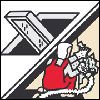If insulation material is stored outdoors, it must be protected from rain. Stack the packages on a flat platform which is not touching the ground, such as on pallets or a similar structure. Cover the stacks with a waterproof tarpaulin or plastic if necessary. Should the insulation material get wet despite these measures, it can be dried and used as normal. Stone wool dries quickly and even when it gets wet, it retains its properties.
Handle the insulation packages in a manner that prevents damage. Be careful to not break the edges or corners of the packages or the insulation, especially during unloading.
PAROC stone wool is easy to cut and handle. Use the specially designed, wide-blade PAROC Cutting knife. When a lot of cutting is required, PAROC cutting tables allow you to easily and consistently achieve the correct angles.
When cutting a slab with facing, cut the slabs from the facing side.
Carry out the insulation work at the earliest possible stage in the building process, when the ventilation is good and access is easy.
Install the insulation carefully and make sure that there are no gaps between slabs or at connections. It is essential that the insulation is tight against the warm side of the structure. Avoid continuous gaps on the warm side of the insulation. If there are warm-side gaps that make contact with the cold side of the structure, the effectiveness of the insulation is significantly reduced
Use slabs that are the right size for each insulation application. Avoid using small pieces (less than 200 mm) as it will increase the risk of gaps occurring.
Overlap the seams between the insulation layers. Avoid placing four corners together.

At the end of the working day, wash your entire body with lukewarm or cold water.
Shower with plenty of water.
Change your clothes after finishing work.

Immediately dispose of all waste.
Clean premises where stone wool is handled frequently, preferably once a day.


Scientific studies show that stone wool fibres do not harm your health. To avoid skin irritation, use protective equipment.
Use personal protection equipment that meets your needs. Keep your work clothing separate from your other clothing.
 Use slabs that are the right size for each insulation application. Use leftover pieces as extra insulation for the roof underneath the blowing wool or as filling together with filling earth and as an insulation layer. They do not harm the environment.
Use slabs that are the right size for each insulation application. Use leftover pieces as extra insulation for the roof underneath the blowing wool or as filling together with filling earth and as an insulation layer. They do not harm the environment.
Recycle or burn empty plastic packaging (PE-LD).
Unless the local authorities have banned the practice, dispose of stone wool waste and stone wool packaging in most normal waste disposal sites.
Stone wool from demolition projects can be destroyed as waste pieces.